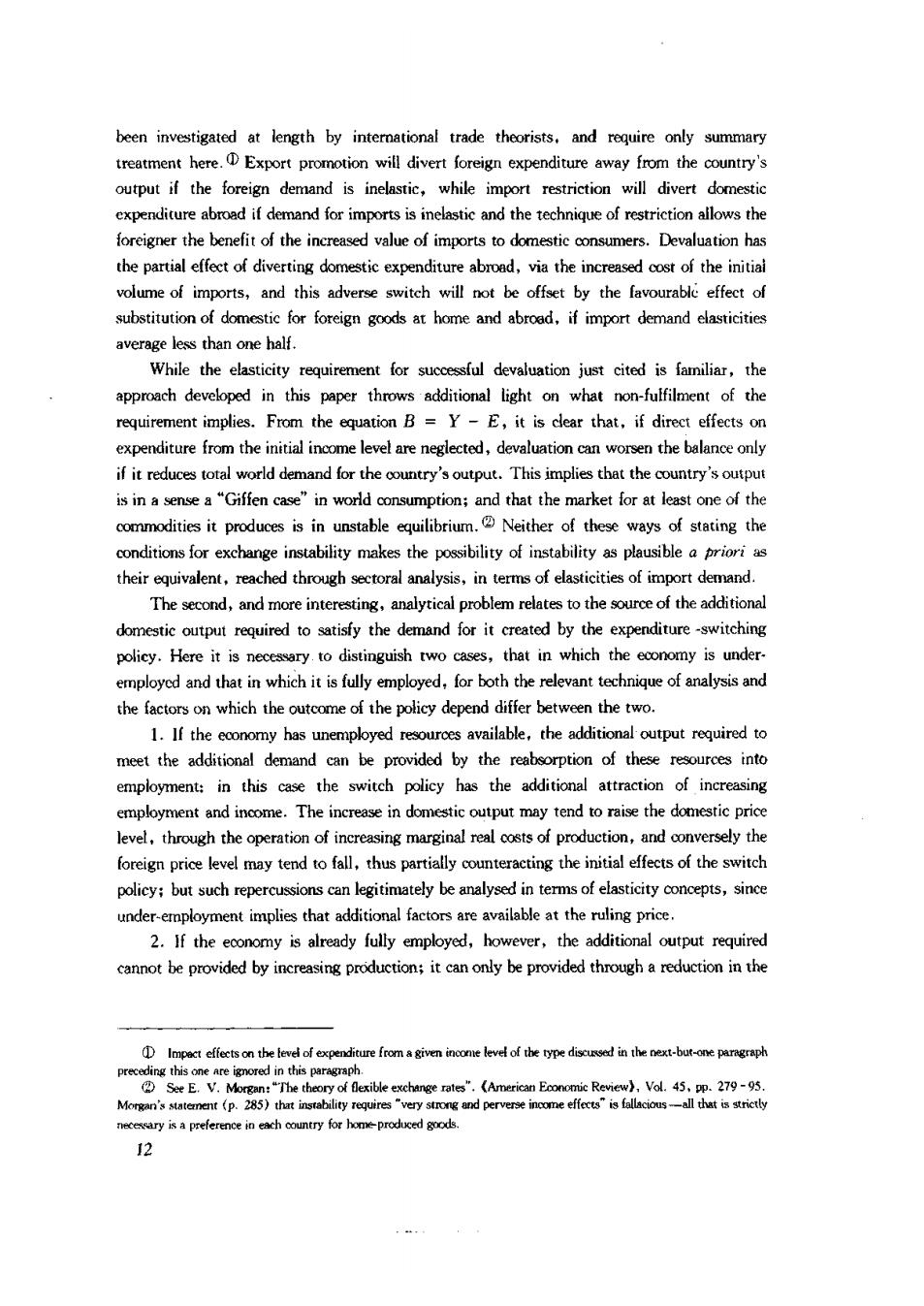
been investigated at length by international trade theorists,and require only summary treatment here.Export divert foreign expenditure away from the counry' output if the foreign demand is inelastic.while import restriction will divert domestic xpenditure abroad if demand for imports is inelastic and the technigue of restriction allows the oreiger the benefitof the incresed value of impors to estic osumers.Devaluation has the partial effect of diverting domestic expenditure abrod,via the increased cost of the initial volume of imports.and this adverse switch will not be offsct by the favourable effect of substitution estic for foreign goodsat home and abrod if import demand elasticities average less than one half. While the elasticity requirement devaluation just cited is familiar,the approach developed in this paper light on what non-fufim of the requirement implies.From the equation B =Y-E.it is dear that.if direct effects on expenditure from the initial income level are neglected,devaluation can worsen the balance only rld demand for theour'ouput.This implies that the coury'soupu is in a sense a"Giffen case"in world consumption;and that the market for at least one of the ommodities it produces is in unstable equilibrium.Neither of these ways ofstating the conditions for exchange instability makes the possibility of instability as their equivalent,reached through sectoral analysis,in terms of elasticities of import demand. problem rete to the theadditiona domestic output required to satisfy the demand for it ereated by the expenditure-switching policy.Here it is necessary.to distinguish two cases,that in which the economy is under. employd and that in which it is fully both the the factors on which the outcome of the policy depend differ between the two 1.If the economy has unemployed resources available,the additional output required to meet the employment:in this case the switch policy has the additional attraction of increasing mployment and income.The increase in domestic output may tend to raise the domestic price level,through increasing margina and conve ersely the foreign price level may tend to fall,thus partially counteracting the initial effects of the switch oolicy:but such repercussions can legitimately be analysed in terms of elasticity concepts,since 2.If the economy is already fully employed,however,the additional output required cannot be provided by increasing production;it can ony be provided through a reduction in the ②SeE.V.MC "The th ge rates",《A rican Eo 12
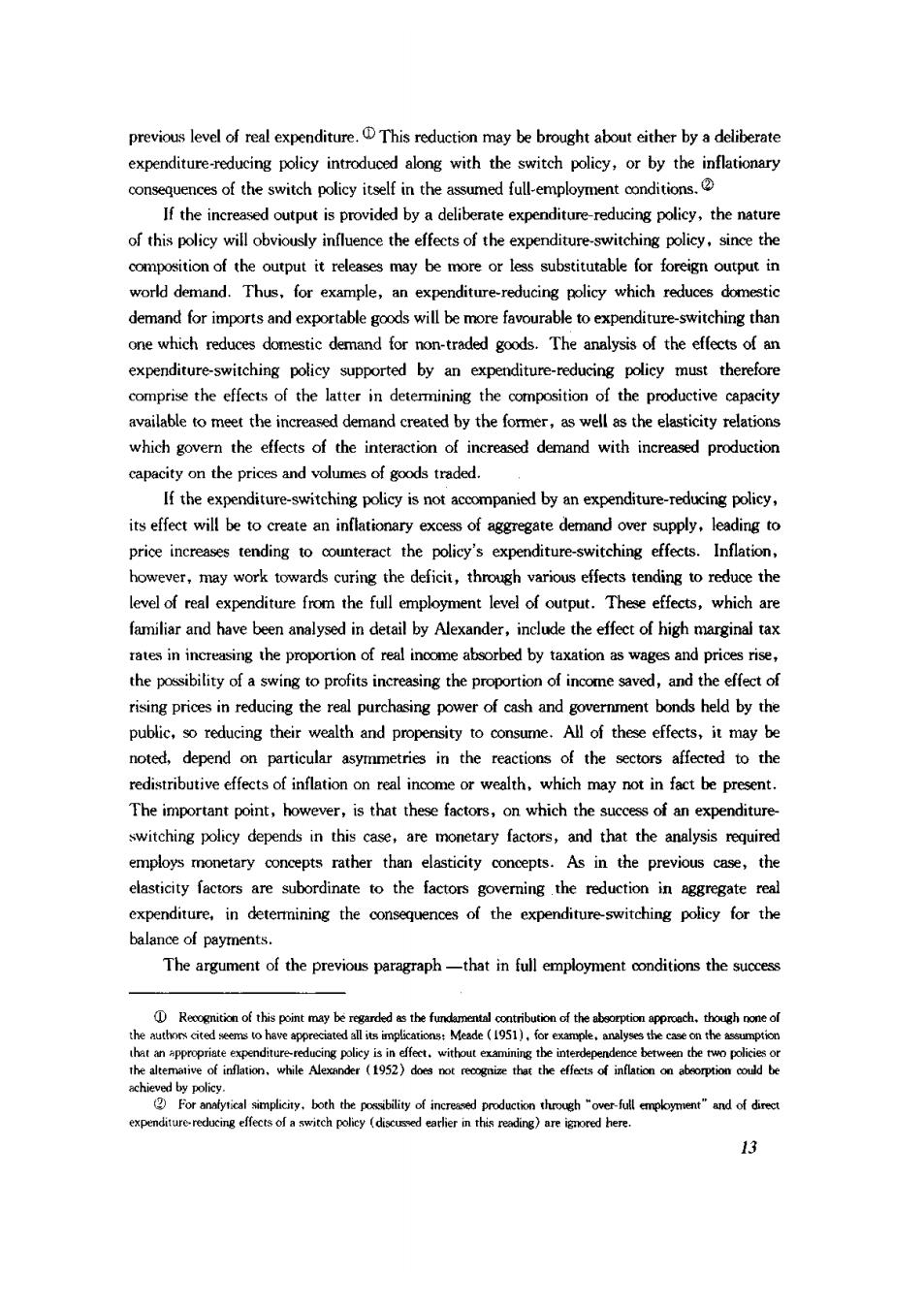
previous levelof real expenditure.This rduction may bebrought about ither byadeibrte expenditure-reducing policy introduced along with the switch policy,or by the inflationary consequences of the switch policy itself in the assumed full-employment conditions. If the increased output is provided by a deliberate expenditure-reducing policy,the nature of this policy will obviously influence the effects of the expenditure-switching policy.since th composition of the output it releases may be more or less substitutable for foreign output in world demand.Thus.for example,an expenditure-reducing policy which reduces domestic demand for imports and exportable goods will be more favourable to expenditure-switching thar one which reduces domestic demand for non-traded goods.The analysis of the effects of an expenditure-swithing policy upported by an expenditre-reducing plicy must therefore comprise the effects of the latter in determining the composition of the productive capacity available to meet the increased demand created by the former,as well as the elasticity relations which govern the effects of the interaction of increased demand with increased production capacity on the prices and volumes of goods traded. If the expenditure-switching policy is not accompanied by an expenditure-reducing policy, pply.leading o price increases tending to counteract the policy's expenditure-switching effects.Inflation, however,may work towards curing the deficit,through various effects tending to reduce the level of real expenditure from the full employment level of output.These effects,which are familiar and have been analysed in detail by Alexander,include the effect of high marginal tax rates in increasing the proportion of real income absorbed by taxation as wages and prices rise rising prices in reducing the real purchasing power of cash and government bonds held by the public,so reducing their wealth and propensity to consume.All of these effects,it may be noted,depend on particular asymmetries in the reactions of the sectors affected to the redistributive effects of inflation on real income or wealth.which may not in fact be present The important point,however,is that these factors,on which the success of an expenditure switching policy depends in this case,are and that the analysis required employs monetary concepts rather than elasticity concepts.As in the previous case,th elasticity factors are subordinate to the factors governing the reduction in aggregate real diture-switching policy for the balance of payments. The argument of the previous peragraph-that in full employment conditions the success he the in 13
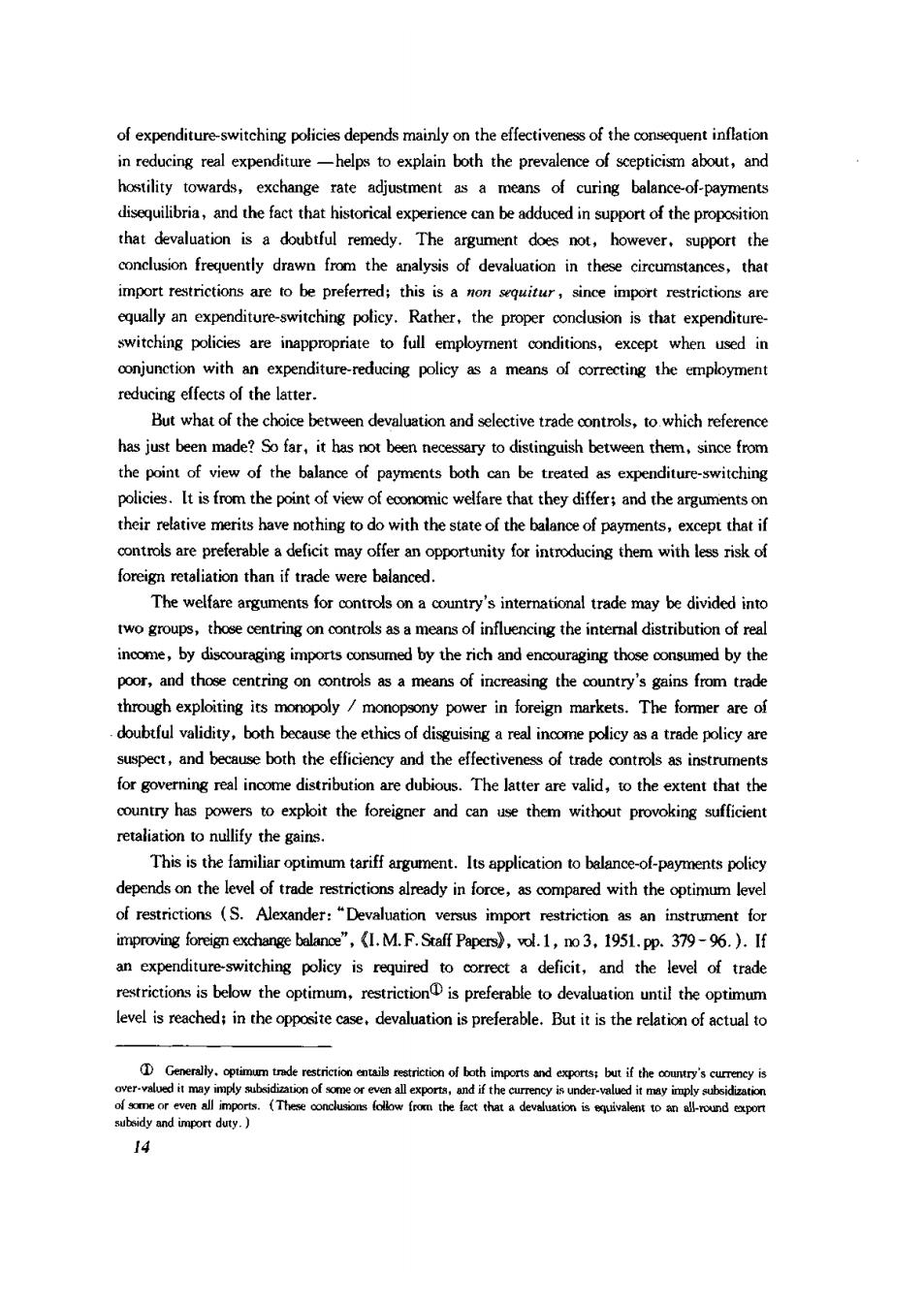
of expenditure-switching policies depends mainly on the effectiveness of the consequent inflation in reducingreal expenditure-helpsto explain both the prevalence of scepticism about,and hostility towards,exchange rate adjustment as a means of curing balance-of-payments disequilibria,and the fact that historical experience can be adduced in support of the proposition that devaluation isa oubful remedy.The argumen does not,however.support the conclusion frequently drawn from the analysis of devaluation in these circumstances,that import restrictions are to be preferred;this is a onqr,since import restrictions are qually an expenditure-switching policy.Rather,the proper ousion is that expenditure switching policies are inappropriate to full employment conditions,except when used in oonjunction with an expenditure-reducing policy as a means of correcting the employment educing the atter But what of the choice between devaluation and selective trade controls.to which reference has just been made?So far,it has not been necessary to distinguish between them,since from the point of view of the balance of payments both can be treated as expenditure-witchin policies.It is from the point of view of economic welfare that they differ;and the argumentson their relative merits haveothing todo with the stateof the balance of payments,except that if foreign retaliation than if trade were balanced. The welfare arguments for contros on a country's international trade may be divided into wogrou,influencing the intemal distribution of rea income,by discouraging imports consumed by the rich and encouraging those consumed by the ntry's gains from trade doubtful validity,both because the ethics of disguising a real income policy as a trade policy are suspect and be both the and the for governing real income distribution are dubious.The latter are valid,to the extent that the country has powers to explit the foreigner and can use them without provoking sufficient nullify the gains. This is the familiar optimum tariff argument.Its application to bance-of-payments policy depends on the level of trade restrictions already in force,as compared with the optimum level ofrestrictions (S.Alexander:"Devaluation versus import ion ent for improving foreign exchange balance",(1.M.F.Saff Papers),vl.1,n3.1951.pp.379-9.).If an expenditure-switching policy is required to orrect a deficit,and the level of trade below the the optimum evel is reached:in the opposite case,devaluation is preferable.But it is the relation of actual to ry's currency s.(These oonclusions foliow from the fact that a devaluation is to an all-round expor
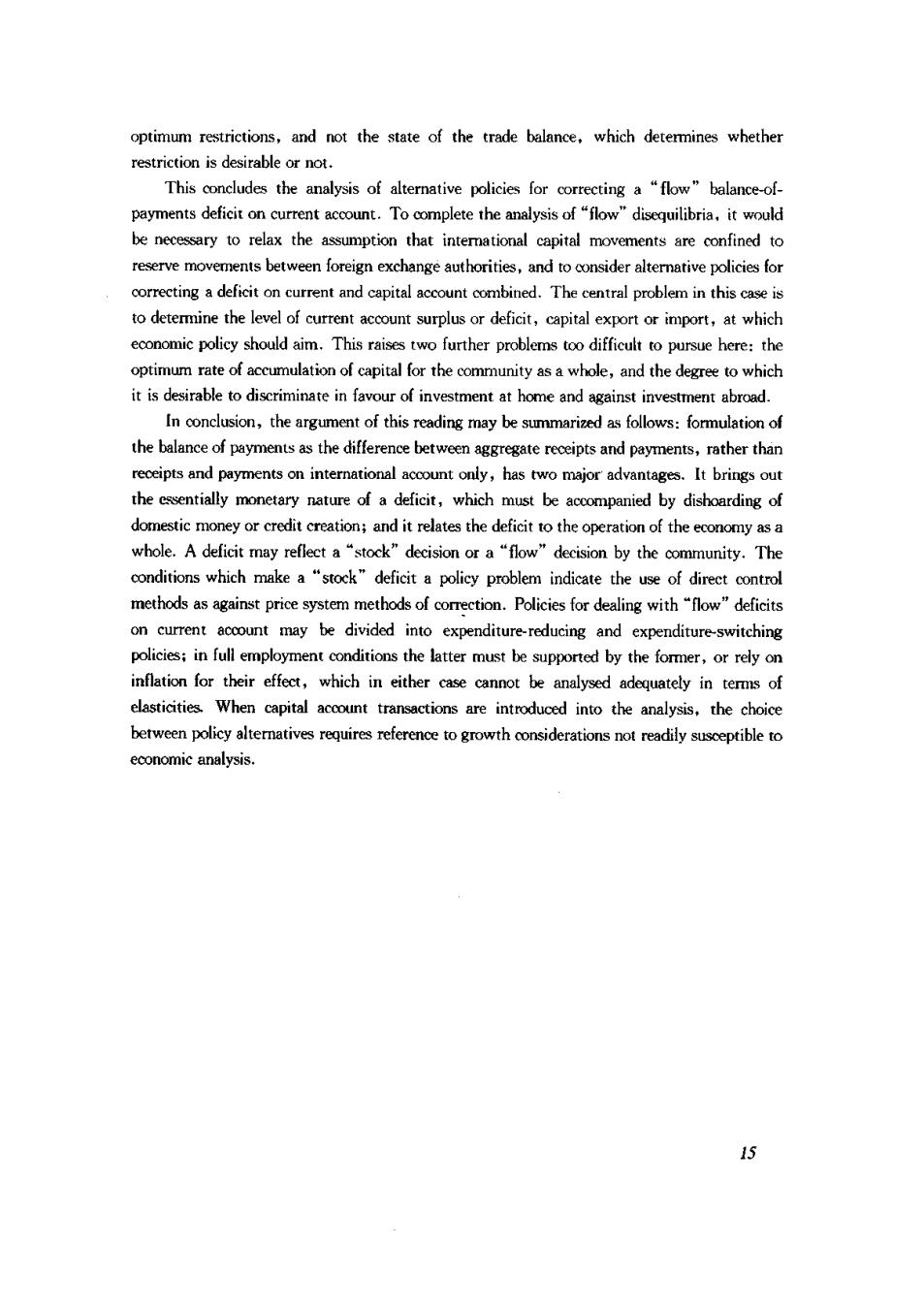
optimum restrictions,and not the state of the trade balance,which determines whether This concludes the analysis of alternative policies for correcting a "flow"balance-of- payments.To complete the aalysis of"flow"disequilibria.it would reserve movements between foreign exchange authorities,and to consider alternative policies for and capital account combined.The central problem in this case is todeteine the level of urrenaccount surpuor deficit,cpital xpmat which economic policy should aim.This raises two further problems too difficult to pursue here:the optimu rate,and the degree towhich In conclusion,the argument of this reading may be summarized as follows:formulation of the balance of the difference between aggregate receipts and payments,rather than receipts and payments on international acoount only,has two major advantages.It brings out the essentially monetary nature of a deficit,which must be accompanied by dishoarding of whole.A deficit may refiect a"stock"decision or a"flow"decision by the community.The conditions which make a "stock"deficit a policy problem indicate the use of direct control mcthods as against pricesystem methods or ealing on current account may be divided into expenditure-reducing and expenditure-switching policies:in ful emplyment nditions the latter must be supported by the fommer, inflation for their effect which in either case cannot be adequately in terms of elasticities When capital acoount transactions are introduced into the analysis.the choice economic analysis 6
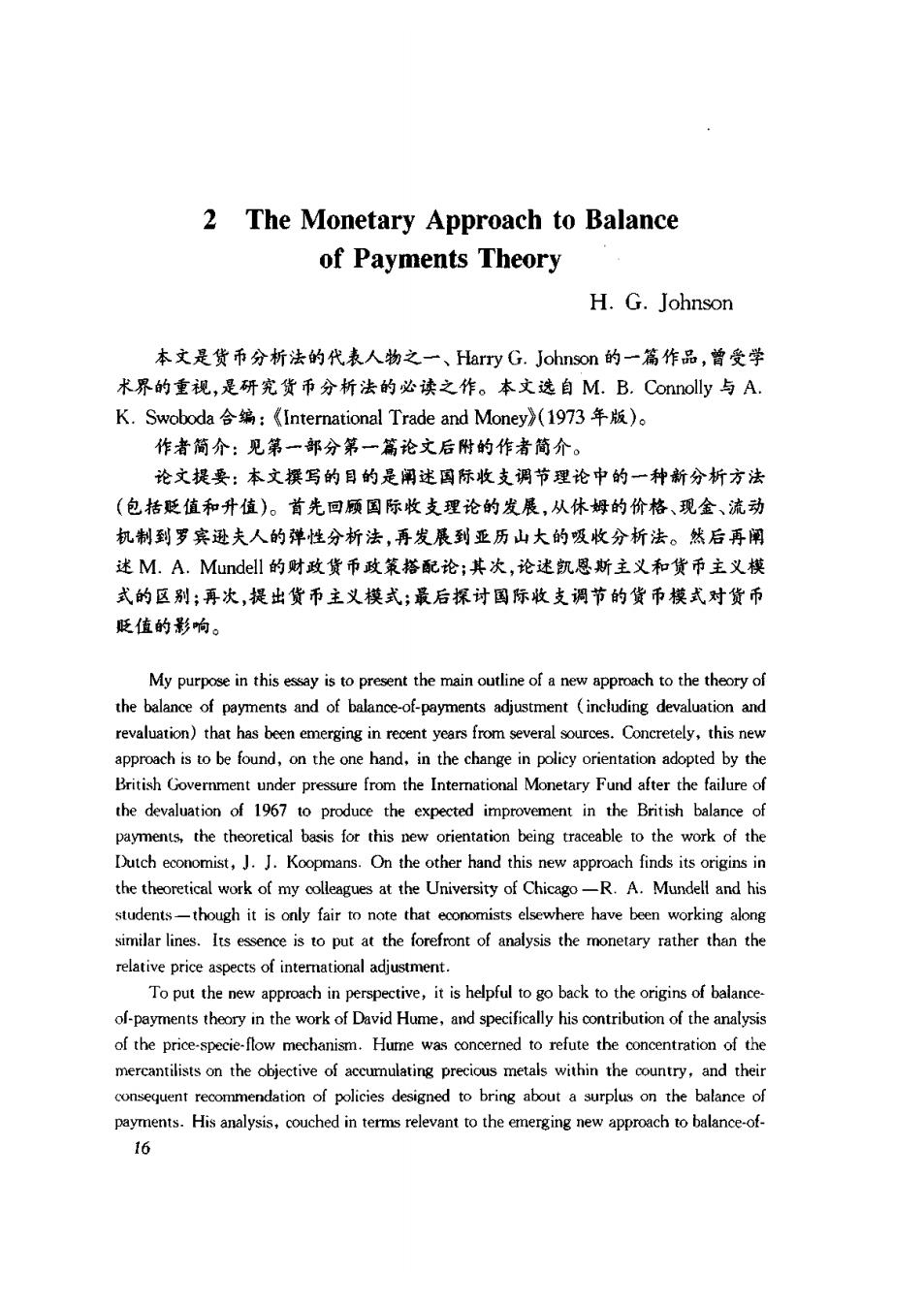
2 The Monetary Approach to Balance of Payments Theory H.G.Johnson 本文是货币分析法的代表人物之一、Harry G.Johnson的一篇作品,曾受学 术界的重视,是研究货币分析法的必读之作。本文选自M.B.Connolly与A. K.Swoboda合编:《International Trade and Money》(1973年版)。 作者简介:见第一部分第一篇论文后附的作者简介。 论文提要:本文撰写的目的是阔述国际收支调节理论中的一种新分析方法 (包括贬值和升值)。首先回顾国际收支理论的发展,从休姆的价格、现金、流动 机制到罗宾逊夫人的弹性分析法,再发展到亚历山大的吸收分析法。然后再阐 迷M.A.Mundell的财政货币政策搭配论;其次,论述凯恩斯主义和货币主义模 式的区别:再次,提出货币主义模式;最后探讨国际收支调节的货币模式对货币 贬值的影响。 My purpose in this essay is to p the balance of payments and of balan-of-payments adjustment (including devaluation and revaluation)that has been emerging in recent years from several sources.Concretely,this new approachistobe found,on theone hand,in the change in plicy orientation adopted by the British Goverment under pressure from the Intemational Monetary Fund after the failure of the devaluation of 1967 to produce the expected improvement in the British balance of ayments,the theoretical basis for this new orientation being traceable to the work of the Dutch economist,.J.Koopmans.On the other hand this new approach finds its origins in the theoretical work of my colleagues at the University of Chicago-R.A.Mundell and his working along similar lines.Its essence is to put at the forefront of analysis the monetary rather than the relative price aspects of interational adjustment To put the new appro in perspective,it is helpful togo back to the origins of balance of-payments theory in the work of David Hume,and specifically his contribution of the analysis of the price-specie-flow mechanism.Hume was concerned to refute the concentration of the the objective precious metals within the and thei consequent recommendation of policies designed to bring about a surplus on the balance of payments.His analysis,couched in terms relevant to the emerging new approach to balance-of- 16